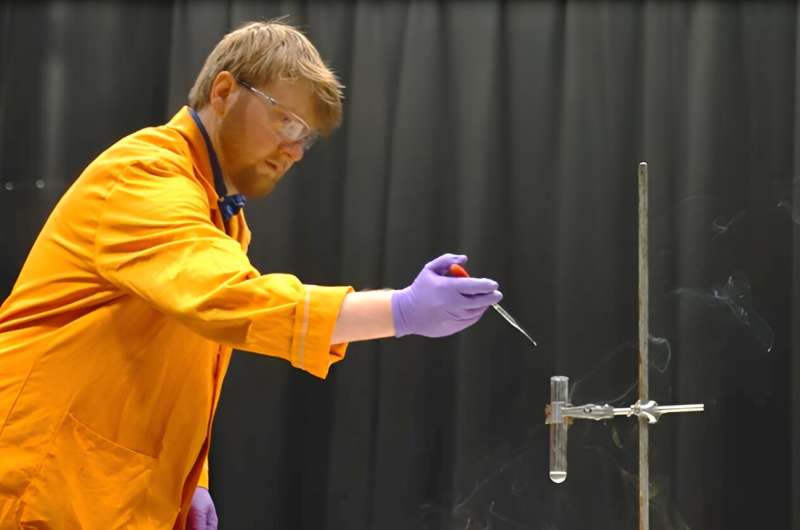This article has been reviewed according to Science X's editorial process and policies. Editors have highlighted the following attributes while ensuring the content's credibility:
fact-checked
trusted source
proofread
Chemist explores the real-world science of Star Wars

A professor at the University of Warwick is exploring the chemistry of the galaxy far, far away this Star Wars Day, May the 4th.
Science fiction is meeting science fact, as Professor Alex Baker discusses the captivating inspiration real-world reactions have had on the Star Wars universe.
The chemist from the University of Warwick explores what may underpin the freezing of Han Solo, the colors of lightsabers, the reactions that power star ships and much more.
The common elements found in the Star Wars realm, Professor Baker notes, are also exploited for their explosiveness and combustibility here on Earth. He has demonstrated how the elements are used in a series of experiments, which he will showcase at a talk at The Royal Institution tomorrow evening.
According to Professor Baker, the Star Wars galaxy, like our own, uses liquid oxygen in rocket engines. "By igniting fuels with oxygen in the engine of a rocket you can produce huge amounts of thrust.
"This is demonstrated in a 'purple cannon fire' reaction that produces oxygen as a product. The oxygen formed then catches light as it passes through a flame. You can see the incredible violence caused by the burning of just a small amount of oxygen gas and fuel."
A common element found in our own universe, sodium, is used as a fuel in the Star Wars universe. "Sodium reacts with water to produce hydrogen gas, often leading to an explosion," said Professor Baker.
Here on Earth sodium has other uses too, for example in some nuclear reactors to transfer the heat generated from the nuclear reactor to turbines that produce electricity.
Chemicals containing nitrogen are also fundamental to warfare in the galaxy far, far away, suggests Professor Baker.
"Baradium nitrate can be found in every Imperial stormtrooper's kit, in their thermal detonators, and also as star ship fuel."
While Baradium is fictional, nitrates and other nitrogen-containing compounds are found in our own galaxy in explosives such as TNT or in rocket fuels—particularly those produced by Soviet scientists. As demonstrated by Professor Baker, the reaction of nitric acid with nitrogen-containing compounds has incredibly violent results.
While cryogens might sound other-worldly, they are used on Earth in freezing. For example, liquid nitrogen and solid carbon dioxide are common examples of cryogens which can be used to freeze objects, such as human eggs in IVF treatment.
Professor Baker suggests that compounds like this could have inspired the freezing of Han Solo—a famous scene in the Star Wars saga.
Professor Baker also reproduces the bright colors of lightsabers by flame test experiments—a staple in most school chemistry classes—which show how different elements produce different colors when heated.
He said, "Elements commonly found in salts are used in these flame tests. They're responsible for the colors in fireworks, so the Star Wars universe could use similar science in lightsabers.
"The colors are created when the elements are heated, causing them to release light in different colors, from bright blues to deep reds. The atoms of these elements house even smaller, negatively charged electrons.
"When these elements are heated, such as by someone lighting a firework with a flame, the electrons become excited. This means they have increased energy resulting in them jumping from their original location (known as a ground state) to another excited state location within the atom.
"As electrons drop back down from their excited state, they release the energy they initially absorbed—in the form of heat and light. What is particularly interesting is each electron drop, and the release of light, is unique to each element.
"Atomically, bright blue and violet lights are highly energetic, the electrons have dropped a relatively long distance (albeit in tiny subatomic scales). Red light is less energetic, dropping shorter distances. This means that a Jedi's blue lightsaber is higher energy than a Sith's red lightsaber."
Provided by University of Warwick





















